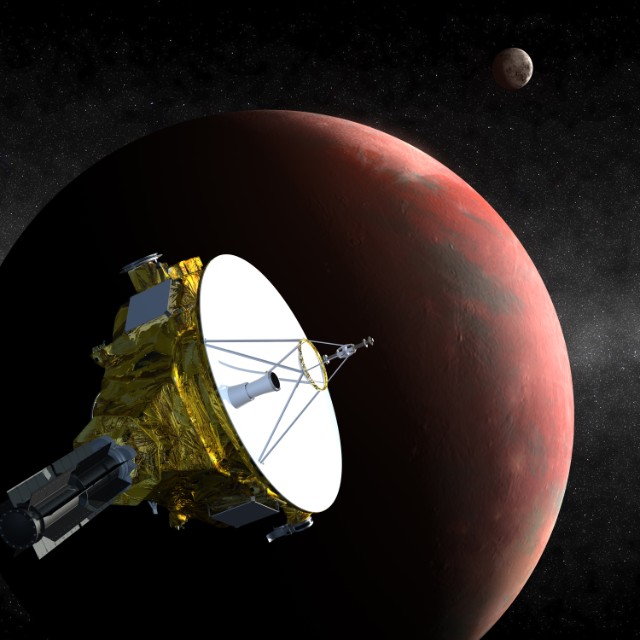Unlocking Charon’s formation story
Astronomers are closer than ever to understanding the origins of the Solar System’s most peculiar moon
Rahul Rao • October 31, 2019

New Horizons, which flew by Pluto and Charon in 2015, continues to lay a path for scientists to read the two worlds’ pasts. [Credit: NASA | Public Domain]
Just two decades ago, Pluto and its largest moon Charon were only understood as mysterious blobs of light in cold outer reaches of the Solar System. Today, not only has NASA’s space probe “New Horizons” explored the Pluto-Charon system in great detail, but we are also approaching a more sophisticated understanding of how the system formed.
In a paper published in July in The Astronomical Journal, the third paper in a sequence poetically named the Pluto-Charon Sonata, astrophysicists Scott Kenyon of the Smithsonian Astrophysical Observatory and Ben Bromley of the University of Utah simulated a model in which Charon is formed from detritus left behind by another object striking Pluto in a cataclysmic collision.
“Our goal was to see if you can make Charon,” Kenyon says. “The model survives that test.”
Charon is perhaps the most unique moon in the Solar System. Because Charon is so massive compared to Pluto, the two bodies’ center of mass actually lies in space outside Pluto. Therefore, the worlds both orbit a point that is outside either. For this reason, some astronomers even consider Pluto and Charon binary partners.
Learning how the Charon formed can help shed light on similar binaries in the universe, all the way from Earth and its own moon to the Kuiper Belt of icy boulders at the edge of the Solar System.
Scientists have gradually developed two opposing models of Charon’s formation. The first is what Kenyon and Bromley call the “hit-and-run” model. In this, Charon originated elsewhere, eventually glancing off Pluto in such a way that the two worlds remained bound together. Erik Asphaug of the University of Arizona likens it to “getting hit by a car with an open window and ending up in the passenger’s seat.” The odds of this are small indeed, so astronomers have sought an alternative.
That alternative is what Kenyon and Bromley call the “graze-and-merge” model. In this model, another Pluto-sized object struck Pluto catastrophically, tearing itself and Pluto’s outer layers apart into a disc that later coalesced into the Pluto-Charon system we know today. It’s much like the impact believed to have formed Earth’s own moon.
This model was first proposed in the 1980s, but it was simulation work by Southwest Research Institute planetary scientist Robin Canup in 2005 that really put it in the conversation. As part of their Sonata, Kenyon and Bromley set out to test this model.
Even though Kenyon and Bromley’s computer simulation forms a Charon-like object, unanswered questions remain. According to Steven Desch, an astrophysicist at Arizona State University not involved in the Sonata, “there’s a lot of loose ends.” In the paper, Kenyon and Bromley agree.
The biggest challenge with Kenyon and Bromley’s model is that Pluto has more moons than Charon. Compared to Charon, the others are tiny boulders with infernal names: Styx, Nix, Kerberos and Hydra. They orbit much further out than Charon, and astronomers who study Charon agree that any accurate model of Charon’s birth must account for the formation of other moons over time.
“We are pretty sure [Pluto’s moons] didn’t form all together at once,” says Kelsi Singer, a planetary scientist at the Southwest Research Institute.
Kenyon and Bromley’s recent simulations didn’t generate enough material to form the outer moons. Here is where the Pluto-Charon Sonata begins to break into static. There’s still the possibility that the outer moons were formed by particles smaller than those the authors accounted for, and Kenyon and Bromley plan to fine-tune their simulations to test this.
And so the hunt continues to understand Charon’s formation, a pursuit that in addition to its scientific importance can be its own reward. “No matter what,” Singer says, “when we go somewhere new in the Solar System, it inspires people.”
Correction: Scott Kenyon is with the Smithsonian Astrophysical Observatory.
1 Comment
Scott Kenyon is with the Smithsonian Astrophysical Observatory. If this correction is made, we can post this story to our website.